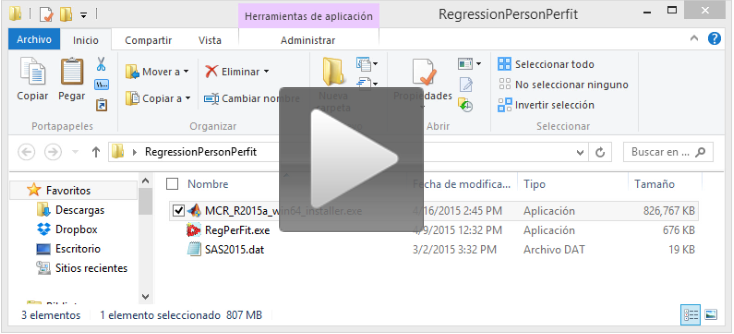
How to run REG-PERFIT
In this section we briefly describe how to run REG-PERFIT as a stand-alone application, and as a Matlab toolbox. First we present a simple dataset (which can be downloaded from the free-download area on our web site). Then we explain how to load data from files. Finally, we explain how to compute the analyses.
Dataset analysed in this tutorial
The Statistical Anxiety Scale (SAS; Vigil-Colet, Lorenzo-Seva & Condon, 2008) is a 24-item narrow-bandwidth instrument intended to measure a specific form of anxiety. The SAS item stems are positively-worded sentences describing typical situations that can be experienced by students enrolled on a statistics course, and the response format is 5-point Likert. According to its authors, the SAS can be analyzed either as a multidimensional measure that assesses three related facets, or as an essentially unidimensional measure that assesses a more general construct of statistical anxiety. Here we will consider the unidimensional solution.
REG_PERFIT can read data from text files and Matlab files (i.e., the typical .mat data files). To replicate our analysis, you should down load the file SAS2015.dat. This is a text file that contains 24 columns of data (one column for the responses of participants to each item). Figure 1 shows an extract of the information contained in the file.
Figure 1. Short extract of data contained in file SAS2015.dat
1 1 1 5 1 1 1 1 1 1 5 1 5 1 4 1 1 1 1 1 1 1 1 1 3 2 1 5 1 1 1 2 4 1 2 1 5 1 4 2 1 1 1 5 1 1 1 1 5 2 3 5 4 2 3 3 5 2 5 2 5 4 5 1 3 2 1 5 3 2 3 3 etc
As can be observed in the figure, numerical values must be used to code the information for each individual. The data must also be separated with a white space.
To load data from files:
Data can be loaded from text files, but also from Matlab data files. The video below shows how to load the three text files presented in the section above.
As you can see in the video, the information from each data file is loaded as a variable that must have a particular name. The name of each variable should be short, comprehensible, and contain no special characters (such as the addition symbol ‘+’). Once all the variables have been loaded, we advise you to save the information in a Matlab data file: this data file can be loaded in the future so that the data can be reanalysed. The last steps in the video show you how to save data, and how to load it.
Matlab users can load any Matlab file (*.mat). If so, all the variables in the file will be available in REG-PERFIT.
How to analyse datasets
The following video shows how to analyse a dataset.
We analyse raw data stored in X. As X is a matrix with 24 columns (one column for each item). All the items are included in the analysis. The next step consists of defining the model. The model is defined as a Graded Response Model, and a single latent trait is expected. In order to compute the analysis, click on the button Compute.If the chosen model is the uni-dimensional two-parameter model, the program allows you to load the item parameter estimates obtained from another program if desired. In this case, you must specify whether the constant D=1.702 is (or is not) included in the discrimination values. Finally, the video shows how to explore and save the numerical and graphical outputs Figure 5 shows what REG-PERFIT looks like after this configuration.

